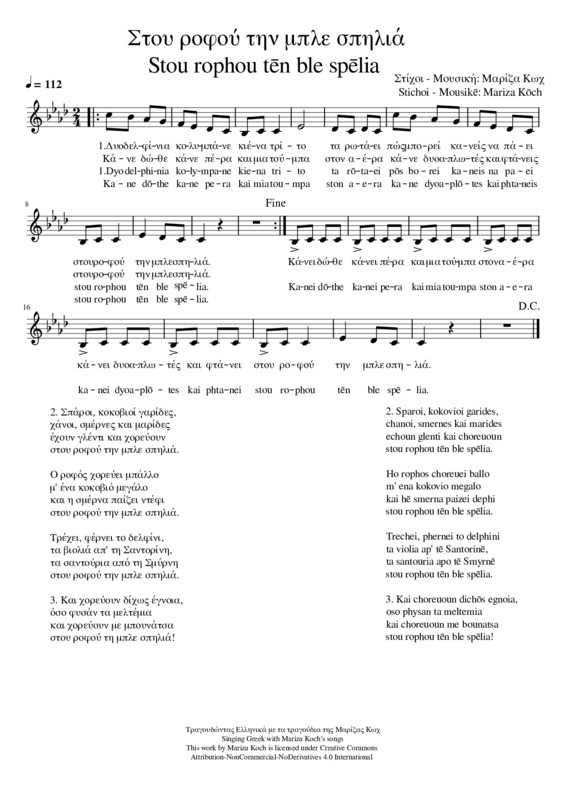
Stou rophou tē mple spēlia

Stou rophou tē mple spēlia
Pronunciation
Articulation of the phoneme /φ/ (ph) and its use in the Greek language [ροφού (rophou), etc.].
Find the phoneme / φ / in the names of the children in class or in other words of the Greek language.
Familiarization with the fast articulation of speech (in speech and in song) through intense rhythm, e.g. “Σπάροι, κοκοβιοί, γαρίδες, χάνοι, σμέρνες και μαρίδες...” (sparoi, kokovioi, garides, chanoi, smernes kai marides…). Render the refrain rhythmically and melodically “κάνε δώθε, κάνε πέρα…” (kane dōthe, kane pera…) with fast and intense rhythm, optional acceleration.
Find the phoneme / φ / in the names of the children in class or in other words of the Greek language.
Familiarization with the fast articulation of speech (in speech and in song) through intense rhythm, e.g. “Σπάροι, κοκοβιοί, γαρίδες, χάνοι, σμέρνες και μαρίδες...” (sparoi, kokovioi, garides, chanoi, smernes kai marides…). Render the refrain rhythmically and melodically “κάνε δώθε, κάνε πέρα…” (kane dōthe, kane pera…) with fast and intense rhythm, optional acceleration.
Speech Comprehension and Production
Practice using the third person of simple present as a description of the story (swim, ask, do, have, dance, run, bring). Use other persons of singular or plural form in the story.
Practice the declension of nouns giving emphasis on the genitive case [ο ροφός-του ροφού (o rophos-tou rophou), το δελφίνι-του δελφινιού (to delphini-tou delphiniou), ο σπάρος-του σπάρου (o sparos-tou sparou), η σμέρνα-της σμέρνας (ē smerna-tēs smernas), etc.].
Marine animals: breams, peacock gudgeons, shrimps, khans, moray eels, picarels, grouper, dolphin. Search for other fish and sea animals in a dictionary and use them to create a short story, poem or dramatized story that highlights the marine life.
Practice the declension of nouns giving emphasis on the genitive case [ο ροφός-του ροφού (o rophos-tou rophou), το δελφίνι-του δελφινιού (to delphini-tou delphiniou), ο σπάρος-του σπάρου (o sparos-tou sparou), η σμέρνα-της σμέρνας (ē smerna-tēs smernas), etc.].
Marine animals: breams, peacock gudgeons, shrimps, khans, moray eels, picarels, grouper, dolphin. Search for other fish and sea animals in a dictionary and use them to create a short story, poem or dramatized story that highlights the marine life.
Music Activities
Instrumentation: listen to the sounds of the musical instruments mentioned in the song (tambourine, violin, santouri) and learn more about them. Familiarization with the musical tradition of the Aegean islands.
Acquaintance and familiarization with balos (traditional dance).
Phrasing of the voice, practice in the refrain of the song to render the text with the right accents. Optional use of acceleration during the refrain section (accelerando).
Selection of a pattern of rhythmic or mimetic movements that will accompany the refrain.
The pupils select the species of fish that are mentioned in the text and accompany them with rhythmic beats repeating four times (e.g. dolphins: one quarter note and two-eighths, peacock gudgeons: two eighths and one quarter note, moray eels: two quarter notes, etc.). Then they repeat this activity reciting the words to themselves while continuing clapping in groups separately and at the same time (practice of internal listening).
Create a sound image on the theme of a sea cave, where each fish “feasts” and “dances” with its company. Use musical instruments, body percussion and useless materials to create marine soundscapes. Recording of sound images, listening and discussion.
Acquaintance and familiarization with balos (traditional dance).
Phrasing of the voice, practice in the refrain of the song to render the text with the right accents. Optional use of acceleration during the refrain section (accelerando).
Selection of a pattern of rhythmic or mimetic movements that will accompany the refrain.
The pupils select the species of fish that are mentioned in the text and accompany them with rhythmic beats repeating four times (e.g. dolphins: one quarter note and two-eighths, peacock gudgeons: two eighths and one quarter note, moray eels: two quarter notes, etc.). Then they repeat this activity reciting the words to themselves while continuing clapping in groups separately and at the same time (practice of internal listening).
Create a sound image on the theme of a sea cave, where each fish “feasts” and “dances” with its company. Use musical instruments, body percussion and useless materials to create marine soundscapes. Recording of sound images, listening and discussion.
Cross-thematic Connections - Greek Culture
Interdisciplinary concepts: environment, tradition.
Development of ecological awareness for the protection of the sea and the marine flora and fauna (fishing, cleaning).
Discussion about the kinds of winds that blow in the Aegean Sea [μελτέμια (meltemia), μπουνάτσες (bounatses), etc.].
Talk about the species of fish that live in the Mediterranean Sea and especially in Greece and how they enrich the Mediterranean diet.
Correlation of the “fish feast” in the cave with the summer festivals on the islands. Enrichment with audiovisual material.
Development of ecological awareness for the protection of the sea and the marine flora and fauna (fishing, cleaning).
Discussion about the kinds of winds that blow in the Aegean Sea [μελτέμια (meltemia), μπουνάτσες (bounatses), etc.].
Talk about the species of fish that live in the Mediterranean Sea and especially in Greece and how they enrich the Mediterranean diet.
Correlation of the “fish feast” in the cave with the summer festivals on the islands. Enrichment with audiovisual material.
Age level
3-7 years old
7-11 years old
Language level
Intermediate
Sea
Animals
Ta chrōmatista tragoudia





